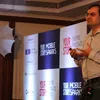Product-market fit isn’t enough for a startup to get funding, says Amit Somani of Prime Venture Partners
In this episode of Prime Ventures’ Prime Knowledge video series, Amit Somani, Managing Partner at Prime Venture Partners, talks about product-market fit and the three other factors startup founders must focus on to draw VC attention.
Every startup has one goal: product-market fit.
Without it, you won't know if what you are building solves a real problem for a large enough market.
Achieving product-market fit may take years for many startups, but once you do, customers resonate with your product and make 10x efforts to try to find and buy your product.
But Amit Somani, Managing Partner at , believes that while product-market fit is important to a company’s future, it may not be enough to attract VC funding.

Amit Somani.
“Most venture capitalists prefer long-term investments and returns. Momentary spikes of growth or temporary indicators do not loosen their purse. Just on the product-market fit front, you will need to achieve more to convince a VC to invest in you and give solid reasons for that decision,” he says.
Watch the Prime Knowledge series with Amit Somani, brought to you by Prime Ventures, an early-stage VC fund investing in technology and product-focused businesses:
Why product-market fit is not enough
The most frequent reason VCs turn down startups with product-market fit is that entrepreneurs have the tendency to believe that they have reached product-market fit when, in reality, they have not. It is natural for a founder to get excited about growth. A momentary surge in revenue flow or an increase in the number of subscribers may seem like customers are finally accepting the product after all the hard work.
However, these are not reliable measures. Growth may happen due to the limited period deal offered or temporary shift in market sentiment. These will not last the test of time.
VCs understand that reaching the coveted balance between product value and customer effort is not a one-year job.
Product-market fit only happens when your product is 10x better than all other similar products currently available in the market, or the value of your product outbalances the customers’ efforts by a factor of 10.
This takes time to realise and reach. Once attained, you need to maintain it to prove its existence. Obviously, VCs remain skeptical of founders’ product-market fit claims and want to look at more than just this one parameter.
What else do VCs look for?
Let us suppose you have product-market fit, whether you realise it or not. You are already ahead in the entrepreneurial curve. Along with this assuring attribute, VCs look at three more parameters to test your eligibility for their funding:
The market size of your product
Product-market fit is really useless if there are not enough customers to resonate with your product. You may have solved the pain points of a few people, but that is not enough to generate substantial returns for your investors.
If you claim that you have product-market fit, the first thing your VC firm will test is your market size.
If you can show a large number of potential customers who are or will be willing to buy your product, you have just crossed the first hurdle to receive your funding.
A viable business model
You must also show the VC your capability to sustain your business. What will the revenue flow be like? What will be its rate? Can you continue to maintain your product’s quality? Is customer service top-notch?
Your planned business model must cover all the relevant areas, close as many loopholes as possible, and ensure sustenance under all possible circumstances. VCs like startups with viable business models who know that their customers will continue to pay for the products that they are offering.
The distribution channel of your product
How exactly are you reaching your expansive customer base? This will cover your supply chain, marketing techniques, retention policies, and so on.
The VCs will also look at your go-to market strategy when revenue flow might dry up, and inspect the possibilities of your financial and customer cushions.
True product-market fit can only happen if there is a healthy distribution channel between your product and the market. Otherwise, your product will sit in the inventory while your customers move on to your competitors.
How to achieve all these in minimum time?
Well, you cannot.
As an early-stage startup, you cannot expect to achieve product-market fit, find a large customer base, create a solid distribution channel and build a viable business model. However, you can still attract VC funding by having these essential parameters in your plan.
It is important to frame convincing strategies around these aspects in your pitch and show the VC that you have all the corners covered. It is as simple as that.
(Edited by Teja Lele Desai)








